Like many high-poverty middle schools, Oakland’s Elmhurst Community Prep is trying to reach students who are academically all over the map. One-third of the students are working at grade level in reading and math, says Principal Kilian Betlach. Another third are one to two years behind. The remaining third are three or four years behind—or more. “You can’t teach them by aiming for the middle and providing these little supports,” says Betlach.
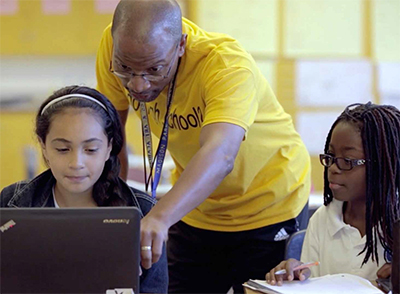
(Photo / The Learning Accelerator / Courtesy Rogers Family Foundation)
Differentiation—teaching students at very different levels of achievement in the same class—is “the greatest challenge facing America’s schools today,” writes Michael Petrilli (see “All Together Now?” features, Winter 2011).
“Teachers are told to sprinkle your differentiation fairy dust,” says Betlach. With 32 students in a class, and no aides, “it’s not possible.”
What is possible?
A foundation-funded experiment is testing whether “blended learning” can personalize instruction in eight Oakland schools. Blended learning combines brick-and-mortar schooling with online education “with some element of student control over time, place, path, and/or pace” of learning, according to the Clayton Christensen Institute definition of the term.
The Rogers Family Foundation, created in 2003 by T. Gary and Kathleen Rogers, launched a blended-learning pilot in four Oakland Unified schools, including Elmhurst, in fall 2012. Two more district schools and two charters were added in 2013. The foundation focuses on improving Oakland’s troubled schools and is funding the pilot with help from the Quest Foundation, the Bill and Melinda Gates Foundation, and others.
Urban schooling doesn’t get much tougher than in Oakland. More than two-thirds of Oakland Unified School District students are Latino or African American; 80 percent qualify for free or reduced-price lunch. One-third are English language learners (ELLs). Only half of disadvantaged 9th graders earn a high school diploma in four years.
Pressured by community groups, the district created small, autonomous, quasi-charter schools like Elmhurst starting in 2001. Scores began rising but remain low.
Despite this bleak picture, Oakland schools do have one advantage as they attempt to transform through blended learning: nobody thinks the status quo is good enough.
Blend and Rotate
“Student control” over the pace of learning is on display in Will Short’s Math 8 class at Elmhurst. Laptop users are working on Khan Academy quizzes geared to each student’s skill level. At the front of the class, a display charts their “energy points,” a measure that includes “on taskness” and the percentage of correct answers. Students receive instant feedback.
Freed from whole-class instruction by the technology, Short has time to reteach concepts to individual students or small groups. Advanced students can move ahead.
At Bret Harte Middle School, which joined the pilot in the second year, Chantel Parnell divides her 6th-grade math students into three groups. On a day in late October, some are using Khan Academy or Google Drive on Chromebooks, while another group is constructing box plots at their desks. The rest are sitting in a circle with the teacher. “Do you understand why you got this answer?” Parnell asks a student.
At that moment, a girl in the Chromebook group raises her hand. A student walks over to help. Oakland schools can’t afford aides in mainstream classrooms, so Parnell has asked students to volunteer to coach their classmates.
Like Parnell, most pilot teachers use the “station rotation model.” Students move between computers, teacher-led discussions, and, sometimes, group projects or independent desk work.
A few teachers use the PC lab. Some of Patricia Wong’s students are working on adding and subtracting negative numbers. Wong explains 4 + (-5) to a boy. “Plus a minus is subtraction,” she says. “What do you do?…Why?”
Meanwhile, one girl is drawing a number line on the screen. Another has moved on to multiplying and dividing with negative numbers. Advanced students are doing word problems. One boy is taking the “mastery challenge,” which pops up randomly. The challenge asks him to add 2.83 + 3.5.
Blended learning isn’t just for math classes at Bret Harte. Teacher Amy Colt uses the online learning program Achieve3000 to teach English and social studies. The program provides Associated Press news stories rewritten to match each user’s reading level, plus a reading quiz to check comprehension and a writing test. Colt circulates, talking to students individually.
The Launch
The idea for the pilot came from Oakland principals who had received earlier Rogers grants. They “weren’t having the impact they wanted with technology” and wanted to do “something larger and deeper,” says Greg Klein, director of blended learning for the Rogers Foundation. Klein is coauthor of “Blended Learning in Practice: Four District School Journeys,” a case study of the Oakland project written with Carrie McPherson Douglass, who’s now with the Cities for Education Entrepreneurship Trust, an umbrella organization for urban reform groups nationwide.
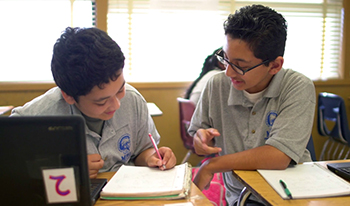
(Photo / The Learning Accelerator / Courtesy Rogers Family Foundation)
Teachers said, “I don’t have enough time to meet the needs of my highest-skilled students or my ELLs. It would be great to personalize instruction.” Those proved to be “gateway drug conversations,” says Klein.
Tracey Logan, who manages technical services for Oakland Unified, was enthusiastic. “We saw an opportunity that was aligned to where we want to go,” she says.
Schools competed for the chance to participate. Working with Education Elements, a company that designs “personalized learning solutions,” the foundation initially chose EnCompass Academy (K–5), Korematsu Discovery Academy (K–5), Madison Park Academy (grades 6–9), and Elmhurst Community Prep (6–8). All are district-run schools in high-poverty, high-crime areas.
“We looked for principals who were strong leaders able to implement change,” says Jane Bryson, who directs the education team at Education Elements. Like their principals, all the teachers within the schools that implemented blended learning were “early adopters” who wanted to try something new. They committed to spending one hour a week after school on collaboration and training, which Rogers funded. That time proved to be critical, says Bryson.
But the pilot’s first year was difficult.
Education Elements trained and supported Madison Park and Korematsu teachers. The company’s software platform lets students sign in to a home page that shows all the learning programs available. Teachers can access a data dashboard to see all the data on each student and create assessment tools.
All of Madison Park’s math teachers and two other teachers volunteered to be in the pilot. At Korematsu, two 4th-grade teachers volunteered to use blended learning to teach both reading and math.
Hoping to test a different approach as well, Rogers brought in Junyo, a small company, to work with Elmhurst and EnCompass Academy. Junyo tried to develop its own platform with a portal for students and a data dashboard for teachers but gave up in mid-September, returned the money, and quit the pilot. Klein and the foundation’s two blended-learning specialists took over tech support and training for the two schools. But lingering effects of the Junyo experiment added to what were already significant challenges.
At the former Junyo schools, the lack of a single portal meant that a student might need to log in separately to five different programs. Klein made sure they could use the same username and password at least.
Rogers had planned to try blending in just 4th and 5th grade at EnCompass, but Junyo signed up all the teachers. Many didn’t realize how much work it would take, says Klein. Implementation was “shallow.”
Elmhurst had a “failure to launch” in what Betlach calls “Year 0.” Junyo’s “advice on devices was divisive and faulty.” Teachers never had reliable Internet access.
Elmhurst’s building, shared with another small middle school, was erected in 1906 and partially rebuilt in the 1920s after a fire. To make room for desktop computers, the foundation paid to have built-in cabinets removed, something teachers had wanted for a long time. But there weren’t enough wireless access points.
On the software front, Rogers learned a lot from the first year about what not to do, says Klein. “We asked teachers to learn multiple education tech tools at the same time.” It was too much.
Across the four schools, pilot middle-school teachers used a number of different learning programs, including Achieve3000, i-Ready, Khan Academy, ST Math, iLearn, and iPass, according to an SRI International report on the pilot’s first year (see First-Year Evaluation sidebar). At the elementary level, Google Drive, Achieve3000, Mangahigh, Khan Academy, Digital Passport, and i-Ready were popular.
“Online content providers can look like bright, shiny objects,” says Bryson. And Rogers was paying.
“It was overwhelming,” says Keara Duggan, an Education Elements staffer who worked with teachers.
“Now we say, start with Khan, and then add more as you see the need,” says Klein. The pilot’s new motto: “Go slow to go fast.”
His other conclusion: “Listen to teachers. Be authentically humble.”
“We did way too much too fast,” says Logan.
“This is really, really hard,” teachers told her. “It’s like being a first-year teacher all over again.”
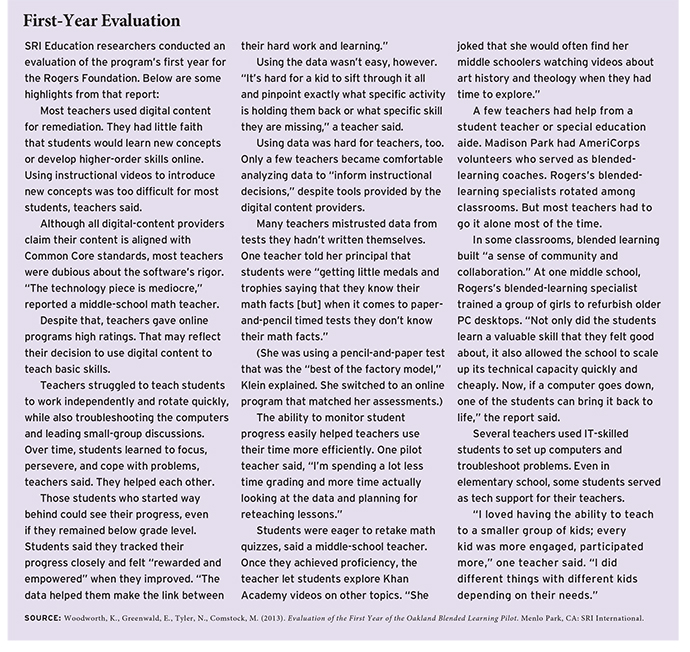
A Leap of Faith
Once teachers gain experience with blended learning, they don’t want to go back, says Logan. “They say, ‘I wouldn’t do it any other way.’”
Technology will “change what teaching looks like”—eventually, she predicts. Right now, however, “it’s a bit of a leap of faith.”
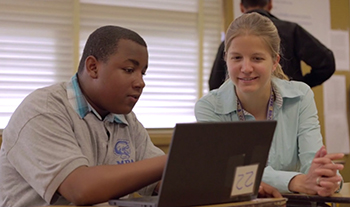
(Photo / The Learning Accelerator / Courtesy Rogers Family Foundation)
Technology can “make the best use of teacher time, adapt to meet students where they are, and encourage collaboration and creativity,” Logan says. It can “expand the classroom. Students don’t just have access to what a teacher knows or what’s in the science book.” Most of all, she wants students to “take ownership of their learning.”
Jessica Tucker wants that for her students, too. Every Friday, Tucker would give a math quiz to her 6th graders at Madison Park. Half would fail. She’d try to reteach the lesson the following week, while introducing the next concept. On Friday, once again, half would fail.
After making the transition to blended learning, Tucker asked students to signal if they were ready for a quiz. Thumbs-up meant ready, thumbs-down meant no way, and a sideways thumb meant “not sure.”
On one Friday, 15 students put their thumbs up. Those students all passed the quiz. Tucker taught an extra lesson for those who needed it before they took the quiz. “It was effective because they felt they had a choice,” she said in a video on differentiation in a blended classroom. “I did an extension lesson at a higher level” for the ones who took the quiz first.
“I’ve done that every Friday since,” says Tucker. “It has improved mastery scores a lot.”
She uses a program called MasteryConnect to design her own tests. If a student does poorly, “I can say, ‘before you retake test, I want you to go to these four Khan videos.’ The kids who didn’t get it after two lessons with me, they’re obviously not going to get it with another lesson with me.”
Tucker wants to instill the belief that “you can’t not master a concept. I don’t care how many times you have to take it. You can’t leave until you learn.”
Year 2 and Beyond
In Year 2 of the pilot, Rogers added two district middle schools, a charter elementary school, and a charter K–8 school, while serving more grade levels at the original four schools.
ASCEND, a district school turned K–8 charter, has a Chromebook for every student and every teacher. Aspire’s Millsmont Elementary, a charter, has gone in a different direction, by designing a mobile computer lab that groups students in “pods” of four.
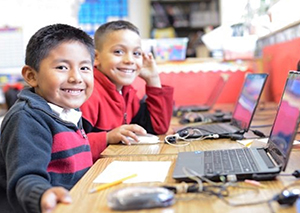
(Photo / Hasain Rasheed / Courtesy Rogers Family Foundation)
Korematsu, one of the original district pilot schools, is blending in nearly every classroom now. EnCompass simplified its program, and the principal hired teachers who are eager to use digital learning.
This year, Elmhurst’s Internet works consistently at a high speed thanks to newly installed access points. Blended learning is starting to work, says Betlach.
“It allows you to gather data on student performance much more quickly,” says the principal. The “exit ticket”—a mini-quiz at the end of each lesson—gives students instant feedback. “Kids say, ‘I really like to know how I did right away.’”
Teachers can track trends and patterns: Which question was problematic? What needs reteaching? “Better data let you target instruction to where kids are,” says Betlach. With students at widely different skill levels, teachers can have “different groups working on different things.”
All the 8th-grade teachers are participating in the blended pilot this year. So are two special-education classes and one 6th-grade math/science class. Teachers who’ve tried it are spreading the word, says Betlach. Nonpilot teachers ask him, “When do I get my Chromebooks?”
Blending More, Spending Less
Rogers is learning how to blend without overspending. The foundation “overpaid” for hardware in Year 1, spending $670 per student, says Klein. Schools bought MacBook Airs, Lenovo PCs, and Windows desktops. This year, the four new schools and the new teachers at Year 1 schools bought Chromebooks for $249 apiece. The price already has fallen to $199, says Klein.
Chromebooks hold up, require less tech support, and have a battery that lasts all day, says Klein. “Google has a cloud-based interface to manage the devices. You can buy 20 Chromebooks and 30 seconds later they’re set up and away you go.”
Teachers are using more free software this year. “You can get a lot of value out of Khan Academy at zero cost,” says Klein. “Then, when you go shopping for premium content, you have a better idea of what you need.”
Because of savings on computers and software, the Year 2 cost is $10,000 per school, half the cost of Year 1, says Klein.
With hardware and software spending going down, Rogers is focusing on helping teachers use technology to improve learning. That’s what really counts, says Klein.
His don’t-go-there example is Los Angeles Unified, which spent $500 million to buy iPads for every student. Implementation was a disaster. Other districts, such as Miami-Dade and Guilford County, North Carolina, have put laptops-for-all programs on hold.
The Rogers pilot is having a ripple effect in Oakland and beyond. Schools that didn’t make the Rogers pilot, both district and charter, are “trying to blend with very little money,” says Klein.
Learning Without Limits (LWL), a district-run elementary that recently converted to a charter, applied for the blended-learning pilot but didn’t make the cut. The school went ahead anyhow. With few computers in the early grades, LWL blends in 4th and 5th grades.
School PTAs and local donors are helping. Some use very low-cost computers refurbished by Oakland Technology Exchange West. Others can afford Chromebooks.
Before the pilot started, only one or two “bleeding edge” charters in Oakland were trying to use blended learning, says Rogers’s Year 2 report. “Just two years later, our eight pilot schools are joined by at least five more district schools, and practically every charter in the city is actively leveraging adaptive online content to personalize instruction.” A majority of Oakland schools have asked the foundation how they could try blended learning.
Oakland Unified is investing $3.5 million—half of its one-time Common Core implementation dollars from the state—to upgrade networks at every school. The district won a $100,000 Gates Foundation planning grant to design a personalized blended learning system at all its schools and is seeking funding for implementation.
Nearby districts have adopted blended learning on their own. Thirty-five miles to the south, next to San Jose, Milpitas Unified is blending instruction in two-thirds of elementary-school classrooms; the district’s teachers designed the plan. At Milpitas High School, the district has provided Chromebooks for students and teachers to use across the curriculum.
Phasing Out the Factory Model
It will take some time to determine how well blended learning works in the Oakland schools. Even though most teachers reported that students were highly engaged when working with digital content and were better able to learn the material, only one-fifth of Rogers pilot teachers said their students did better on benchmark tests the first year (see Figure 1).
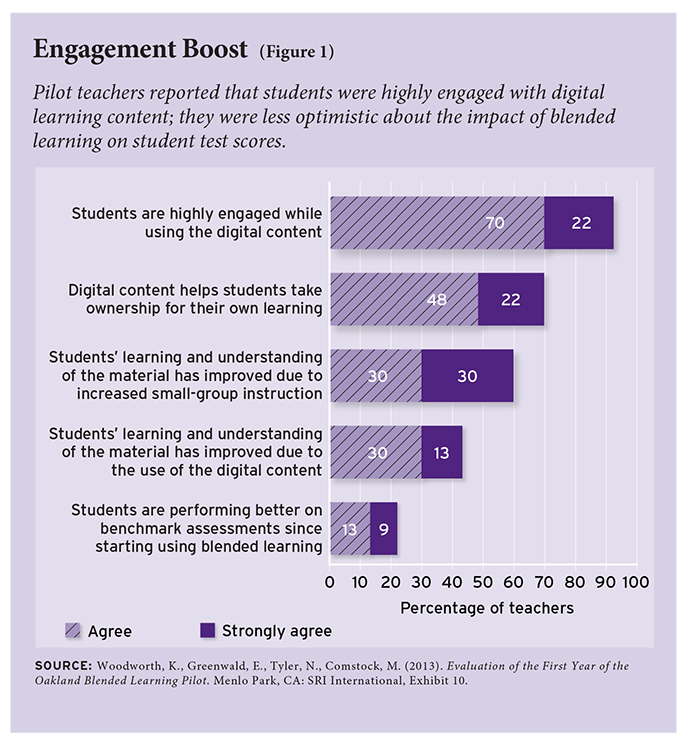
Results on the 2013 California Standards Tests were “mixed,” says Klein. Madison Park’s 6th graders outperformed the district average in math and algebra students also showed progress. Korematsu, which blended only in 4th grade, showed gains in reading, where blended learning was concentrated, and smaller gains in math.
Rogers predicts “dramatic changes to student outcomes in years two, three, and beyond” as personalized learning takes hold.
Because there’s no control group, it will be difficult to tell whether higher scores are due to the pilot or other factors. And California’s state testing system will not report scores next year because of the transition to Common Core standards, which will make it even harder to track progress. The district gives the Scholastic Reading Inventory exam three times a year, however, which will enable the pilot schools focusing on English language arts to see what’s working (see Figure 2). In addition, some online content programs have built-in assessments that can be used to evaluate students’ progress.
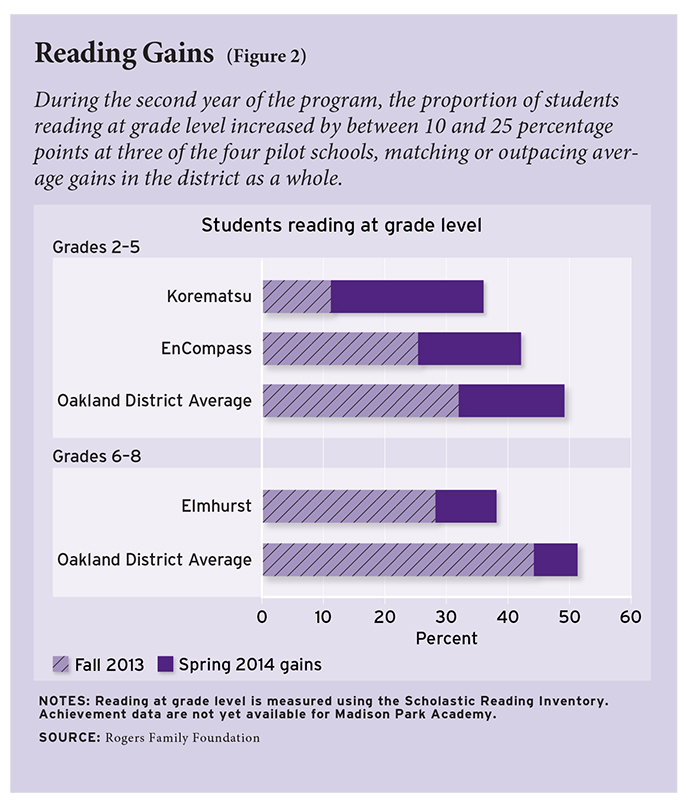
The foundation is surveying teachers and students to see how attitudes are changing.
In the pilot’s first year, “blended learning…encourage[d] experimentation,” wrote Klein and Douglass in a January 2013 update to the case study. “We see teachers dramatically changing their schedules, grouping structures and habits more frequently and with more excitement and openness than ever before.”
In the second year, “we have a handful (and growing number) of teachers who are truly innovating at each site and are pushing their peers to both play and learn alongside their students,” they wrote in an earlier update.
The foundation’s focus now is on training teachers on programs and tools, connecting them to coaches, and helping teachers collaborate with each other.
Education technology often is used to do the same old thing—only with less paper, says Klein. Technology must change teaching in order to make a difference. That’s the foundation’s goal in Oakland. Yet Klein recognizes that much has stayed the same at the pilot schools. “Our pilots highly disrupt the status quo at schools, but it’s the same teaching staff ratio, grade levels, and bell schedule.”
“We’re not necessarily funding next-generation models,” says Klein. “We’re less funding the future and more funding the breakdown of the past. It’s the beginning of the end of the factory model.”
“Next-generation learning” will go much deeper, Klein predicts. But, first, he wants to show that the blended pilot is helping students learn more.
“In education, we took down the chalkboards and put up the whiteboard, but it probably didn’t make a lick of difference in academics,” says Klein. “Now we’re moving to student-facing devices. We’re hopeful we can help Oakland do it well. How can we transfer teaching and learning in a daily way in core classes?”
Blended learning is “not transformational right now,” he says. He thinks it will be.
Joanne Jacobs, a former San Jose Mercury News editorial writer and columnist, writes about K–12 education and community colleges at joannejacobs.com and ccspotlight.org.
This article appeared in the Fall 2014 issue of Education Next. Suggested citation format:
Jacobs, J. (2014). Beyond the Factory Model: Oakland teachers learn how to blend. Education Next, 14(4), 34-41.


